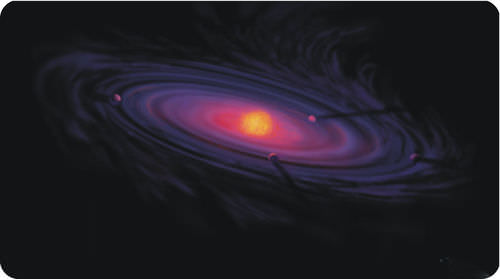16.1太阳和行星的形成
章节大纲
-
Where are stars born? Are stars being born right now?
::恒星在哪里诞生?Stars are born in like the one in the picture. Gravity pulls material together. When it is extremely dense, it begins nuclear fusion . That is, it becomes a star. We can see places where stars are being born right now. Of course, it takes light a long time to travel to us. So what we see right now may have happened many millions or even billions of years ago.
::恒星的诞生与照片中的恒星一样。重力将材料拉在一起。当它非常稠密时,它就会开始核聚变。也就是说,它会成为一颗恒星。我们可以看到恒星诞生的地方。当然,我们需要很长的时间才能到达我们这里。所以我们现在所看到的可能发生在数百万年前,甚至数十亿年前。Formation of the Solar System
::太阳系的形成Our solar system began about 5 billion years ago. The , planets , and other solar system objects all formed at about the same time. The leading hypothesis for how they formed is called the nebular hypothesis .
::我们的太阳系大约在50亿年前就开始了。行星和其他太阳系的物体都是同时形成的。它们是如何形成的主要假设被称为星云假设。The Solar Nebula
::太阳星云The Sun and planets formed from a giant cloud of gas and dust. This was the solar nebula . The cloud contracted and began to spin. As it contracted, its and pressure increased. The cloud spun faster and formed into a disk. Scientists think the solar system at that time looked like these disk-shaped objects in the Orion Nebula . New stars are forming in the Orion Nebula today.
::太阳和行星由巨大的气体和尘埃云形成。 这是太阳星云。 云层收缩并开始旋转。 随着它的收缩, 云层和压力会增加。 云层会更快地滑动, 形成一个磁盘。 科学家们认为当时的太阳系看起来像猎户座星云中的磁盘形状物体。 今天的猎户星云中正在形成新的恒星。Solar System Bodies Form
::太阳系机体表格Gravity pulled a lot of material to the center of the cloud. Temperatures and pressures at the center of the cloud were extreme. It was so hot that nuclear fusion reactions began. A star was born—the Sun. In these reactions, hydrogen fuses to make helium. Extreme amounts of energy are released.
::引力将许多材料拉到云的中心,云的中心温度和压力是极端的。它非常热,核聚变开始反应。一颗恒星诞生了太阳。在这些反应中,氢引信可以制造氦,释放出极量的能量。An artist’s painting of a protoplanetary disk. Meanwhile, the outer parts of the disk were cooling off. Matter condensed from the cloud. Small pieces of dust started clumping together. These clumps collided and combined with other clumps. Gravity brought more clumps together to make larger bodies. Gravity at the center of the disk attracted and metal. Lighter material remained farther out in the disk. Eventually, these small bodies grew to become the planets and moons that we find in our solar system today.
::同时,磁盘的外部部分正在冷却。 物质从云中凝结。 小片尘埃开始堆在一起。 这些碎屑相撞, 与其他碎屑合在一起。 重力把更多的碎屑聚集在一起, 以形成更大的体体。 磁盘中心引来重力和金属。 较轻的材料在磁盘中停留得更远。 最终, 这些小块的尘埃开始形成我们今天在太阳系中发现的行星和月亮。The Planets
::行星Since gravity pulled the heavy material inward, the inner planets—Mercury, , Earth, and Mars—are made of rock and metal. The outer planets— , , , and Neptune—condensed farther from the Sun ( Figure ). They are made from lighter materials such as hydrogen, helium, water , ammonia, and methane. Out by jupiter and beyond, where it’s very cold, these materials form solid particles. Dwarf plants, , and formed too.
::由于重力将重物质引向内向,内行星 — — 内行星 — — 军事、地球和火星 — — 是由岩石和金属组成的。外行星 — — 外行星 — — 以及海王星 — — 离太阳更远(图层 ) 。 外行星 — — 外行星 — — 以及海王星 — — 和海王星 — — 由氢、氦、水、氨和甲烷等较轻的材料制成。 外行星和外行星 — — 冷却的外行星 — — 形成固体颗粒。 矮人植物也形成并形成。The Sun and planets (note that this image is old enough to include Pluto, which is no longer considered one of the planets). The nebular hypothesis explains the basic features of the solar system:
::星际假设解释了太阳系的基本特征:- The center of the nebula became a star, our Sun!
::星云的中心变成了一颗恒星,我们的太阳!
- The orbits of the planets lie in nearly the same plane.
::行星的轨道几乎在同一平面上
- The planets revolve in the same direction.
::行星朝同一个方向转来转去
- Most of the planets rotate in the same direction.
::大多数行星都向同一方向旋转。
- The axes of rotation of most planets are nearly perpendicular to the orbital plane.
::大多数行星的旋转轴几乎与轨道平面垂直。
- The oldest Moon rocks are 4.5 billion years old.
::最古老的月球岩石有45亿年的历史
Our view of the solar system started with the ancient Greeks who reasoned that since some points of light—which they called planets—moved faster than the stars, they must be closer.
::我们对太阳系的看法是从古希腊人开始的,他们认为,由于一些光点——他们称之为行星——的移动速度比恒星快,它们必须更接近。Summary
::摘要- A giant cloud of dust and gas is called a nebula. A nebula collapsed to form the solar system. This is the nebular hypothesis.
::巨大的尘埃和气体云被称为星云,星云崩溃形成太阳系,这是星云假设。
- When hydrogen began to fuse into helium, the Sun became a star.
::当氢开始熔化成氦时,太阳变成了一颗恒星。
- Planets nearer the Sun are formed of denser metal and rocks. Planets farther out are lighter and gaseous.
::靠近太阳的行星由较稠密的金属和岩石组成,远处的行星较轻,气态较强。
Review
::回顾- What is the nebular hypothesis?
::什么是星云假设?
- What was the solar nebula?
::太阳星云是什么?
- How did the material at the center of the solar system become a star?
::太阳系中心的物质是如何成为恒星的?
- What are the categories of bodies in the solar system? In general, where can they be found?
::太阳系中的物体类别是什么?一般而言,在哪里可以找到它们?
- What is the evidence that supports the nebular hypothesis?
::支持星云假设的证据是什么?
Explore More
::探索更多Use the resource below to answer the questions that follow.
::利用以下资源回答以下问题。- What is a protostar?
::什么是原星号?
- At what temperature did nuclear fusion begin?
::核聚变从什么温度开始?
- When was our star born? How much longer will it last?
::我们的恒星是什么时候诞生的?
- How does the Sun produce its light?
::太阳如何产生光芒?
- What does recent research suggest about the birth of our Sun?
::最近的研究对太阳的诞生有何看法?
- What was the Big Bang?
::什么是大爆炸?
- The center of the nebula became a star, our Sun!


